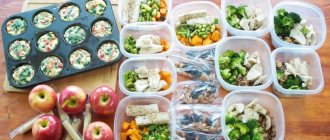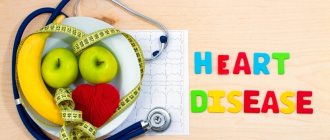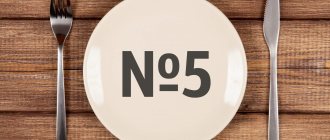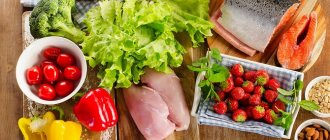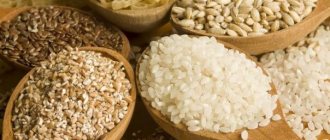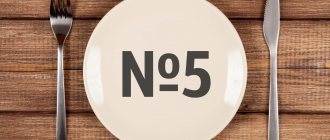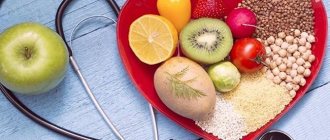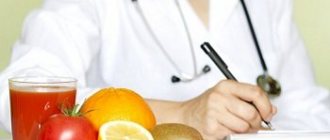11/27/2019 Article
- general characteristics
- Table "Do's and Don'ts"
- Menu for the week
The “11 table” diet is designed to help an organism weakened by illness cope with infectious and other diseases and quickly restore strength after illness.
Indications for use of the diet:
- mild exacerbation or completion of treatment for tuberculosis of the lungs, bones, joints and lymphatic system;
- for patients with exhaustion of the body after severe infectious diseases, serious injuries and operations;
- patients after lobar pneumonia and people suffering from anemia with low body weight.
The main goals of nutrition are to increase hemoglobin levels, strengthen the immune system, compensate for the deficiency of biologically active nutrients and vitamins, and also increase the body's resistance to infections.
Indications
Help Table number 11 is one of fifteen therapeutic and preventive diets developed by the Soviet therapist, nutritionist and professor M.I. Pevzner. Each numbered therapeutic type of nutrition founded by him is aimed at the prevention and treatment of certain diseases. Treatment table No. 11 is indicated for mild exacerbation or upon completion of treatment for tuberculosis of the lungs, bones, joints and lymphatic system, as well as for patients with exhaustion of the body after severe infectious diseases, serious injuries and operations. The diet is also prescribed for low body weight, patients after lobar pneumonia and people suffering from anemia. The main goals of nutrition are to increase hemoglobin levels, strengthen the immune system, compensate for the deficiency of biologically active nutrients and vitamins, and also increase the body’s resistance to infections.
Chemical composition and energy value of dietary table No. 11
Proteins: 110–120 g (50 g animal proteins). Fats: 80–90 g (at least 30 g of vegetable fats). Carbohydrates: 250–350 g. Daily calorie content: 2,200–2,700 kcal. Free liquid: 1.5–2 l. Table salt: 6–8 g Vitamins: retinol (A) – 1 mg, thiamine (B1) – 2 mg, riboflavin (B2) – 4 mg, nicotinic acid (B3) – 30 mg, ascorbic acid (C) – 200 mg. Macroelements: sodium – 4 g, calcium – 1.4 g, magnesium – 0.6 g, phosphorus – 2.2 g. Optimal food temperature: from 15 to 60 degrees Celsius.
Peculiarities
One of the main conditions for the name of this diet is the absence of problems with the gastrointestinal tract.
The diet is high in calories - the patient consumes about 3000–3500 kcal per day. Calorie intake increases due to increased consumption of protein and fortified foods; the amount of carbohydrates and fats also increases, but within moderate limits.
Additional minerals and vitamins are introduced into the diet, and the daily calcium intake is increased.
Article on the topic
The power of blood. What should you eat to maintain your hemoglobin level? There are no special requirements for heat treatment of food, but you need to eat at least 5 times a day. It is recommended to drink as with a normal diet - at least 1.5 liters per day.
general characteristics
The diet is physiologically complete and has an increased calorie content due to an increase in the content of proteins (especially animals), fats and carbohydrates, easily digestible foods, mineral salts, and vitamins. Chemical and mechanical irritants of the stomach and bile ducts are limited in the diet. The diet is enriched with ascorbic acid and dietary fiber, rich in dishes and products that improve appetite and have a beneficial effect on the normalization of blood counts. Dishes are prepared boiled, stewed, baked, pureed or unmashed, or steamed. Food temperature is 15-65 degrees Celsius.
Chemical composition and calorie content:
- proteins - 120 g (of which 60% animal origin),
- fats - 100-110 g (of which 1/3 are vegetable),
- carbohydrates - 350-500 g,
- calories - 3000-3500 kcal,
- table salt - 12-15 g,
- free liquid - 1.5-2 l.
Diet:
4–6 times a day.
An increased intake of vitamins is necessary in the form of vegetables, fruits, rosehip infusion, calcium salts in the form of a variety of dairy products. When prescribing a diet for patients with diabetes, refined carbohydrates (sugar) are excluded. Table salt is used in the usual amount. For tuberculosis, limit table salt to 6–8 g/day. It is necessary to consume foods that contain large amounts of all essential substances in optimal proportions: meat, eggs, fish, dairy products, vegetables and fruits.
For iron deficiency anemia (since proteins stimulate and fats reduce the absorption of iron from mixed foods), the amount of protein in the daily diet is increased to 140 g, animal protein accounts for 90 g from beef, meat products, as well as fish, liver, egg white, low-fat cottage cheese. The amount of fat is reduced by 5-10%, that is, to 80–90 g/day due to lean varieties of meat and poultry; refractory fats are excluded.
Menu
Therapeutic diet number 11 can be called one of the simplest dietary tables, since almost all foods and dishes are allowed. In particular, all types of meat, poultry and fish, any seafood, offal, liver, sausage, frankfurters and even canned fish.
Also allowed are eggs (in any form and any preparation), dairy products, vegetable and butter, all types of soups, cereals, pasta, bread (both wheat and rye), fruits and vegetables, spices and sweets.
All drinks are consumed, including strong tea and coffee, but excluding any alcoholic beverages. Juices and fruit drinks made from fruits and berries and rose hips will be of particular benefit.
Only very fatty varieties of meat and fish are prohibited; beef and lamb fat and hot and fatty sauces should be strictly avoided. Also, you should know moderation in everything, this especially applies to spices and sweets; in particular, it is not recommended to eat cakes and pastries with a lot of cream.
Question answer
How to choose milk and dairy products? Advice for buyers But of all dairy products, special attention should be paid to cottage cheese and cottage cheese.
Sample diet menu No. 11.
- First breakfast: fresh cabbage salad with apples and sour cream, omelette, oatmeal with milk, tea with milk.
- Second breakfast: cheese, tea.
- Lunch: borscht in meat broth with sour cream, fried chicken with boiled rice, compote.
- Afternoon snack: rosehip decoction.
- Dinner: meat zrazy stuffed with onion and egg, carrot puree, buckwheat casserole with cottage cheese, tea.
- At night: kefir.
A medical diet is prescribed only by the attending physician , who has full knowledge of the medical history of a particular patient.
Dish recipes
Sesame Cookies Recipe
Ingredients:
- 90 gr. Sahara;
- 1 tsp baking powder;
- 1 egg;
- 1\2 sesame seeds;
- 125 gr. butter;
- 260 gr. flour.
Preparation:
Pour flour, sugar and baking powder into a container and make a hole in the middle. Add softened butter, egg and more sugar, knead the dough. Roll into balls, cover the plate with sesame seeds, roll each piece, and place on a baking sheet using baking paper. Bake in an oven preheated to 170 degrees for 1/3 hours.
Apple pancakes recipe
Ingredients:
- 2 fruits;
- 2 tbsp. l. sugar (more for sour fruits);
- 1 egg;
- 3 tbsp. flour;
- Oil for frying.
How to cook: wash the fruits, cut into quarters, get rid of the seeds, pass them through a meat grinder or food processor. Add egg, sugar, flour (the amount varies depending on the consistency of the dough), mix. Fry in vegetable oil like regular pancakes until a golden brown crust forms.
Cranberry juice recipe
Ingredients:
- 600 gr. berries;
- Sugar to taste;
- 2.5 liters of water.
Preparation: wash the fruits and mash them using a masher. Squeeze the juice using cheesecloth into a plastic container. After filling the pan with cake, pour in water, wait until it boils, strain the resulting liquid through cheesecloth, and discard the “scales.” Pour in cranberry juice and sugar, mix well and let cool.
THESE ARTICLES WILL HELP YOU LOSE WEIGHT
Diet "Table No. 11"
Diet table No. 11 according to Pevzner is a diet recommended for patients with chronic diseases that affect body weight: tuberculosis of the lungs, bones, lymph nodes. The diet also strengthens the body's defenses in case of anemia, exhaustion after surgery, severe infectious diseases or serious injuries.
This diet is rich in all the vitamins and beneficial micro- and macroelements necessary for a weakened person.
Characteristics of the diet
The main features of this diet are:
- increased calorie content of the daily diet;
- increased content of animal fats in dishes;
- every day the patient who is prescribed this diet must consume dairy and fermented milk products;
- integral components of the 11th type table - salt (about 10 g per day), easily digestible proteins, various flavorings and seasonings that stimulate appetite are also encouraged;
— in addition, foods rich in healthy dietary fiber play an important role in the diet, which contribute to good digestion of food and complete cleansing of the intestines.
What are the goals of diet table No. 11?
The diet is high in calories, enriched with fiber and proteins. It quite quickly leads to the expected result - weight gain. In addition, the diet helps:
- improve overall well-being and normalize human immunity;
- stimulates active blood circulation and increases hemoglobin;
- accelerates tissue regeneration;
- normalizes sleep and improves mood.
General dietary recommendations
This diet is characterized by a high calorie content - an average of 3300 Kcal daily. Any culinary processing of products is permitted, unless otherwise limited by other diseases of the patient. The number of meals during the day is at least 5 times. The food temperature is normal.
And although active physical activity is not allowed if the body is weakened, daily walks in the fresh air activate the metabolism and help speed up the patient’s recovery.
Diet table No. 11: allowed and prohibited foods
This diet is considered the most democratic - there are no strict restrictions or recommendations on what foods can and cannot be eaten. The lists of prohibited and permitted products are rather advisory in nature. But you should still remember that the high calorie content of daily meals can create additional stress on the liver and bile ducts.
To reduce the load on these organs, it is better to adhere to the following list:
| Name of dish (product) | Authorized Products | Relative restrictions |
| First meal | Any, including milk soups | It is worth limiting overly fatty broths |
| Main courses (meat, fish) | Any fish or meat | Relative restriction on fatty types of meat, fish, sausages or offal dishes. Lamb should also be excluded from the diet |
| Second courses (side dishes) | Any cereals Pasta Potatoes | |
| Dairy and fermented milk products | Any food, fresh or processed, must be eaten | |
| Vegetables | Any, including greens, in various culinary treatments and without it. It is advisable to include in the diet daily | |
| Fruits | Any, and half of them should be eaten raw | |
| Sweet products | Any | Limit - cakes or cakes with rich buttercream |
| Bakery products | All types | |
| Others | Eggs in any culinary preparation | Margarine, full-fat mayonnaise, other fatty or flour sauces, palm oil Semi-finished products, canned food, fast food |
| Beverages | Any, if there are no restrictions from other diseases |
Diet table No. 11. Menu for the week
Monday
- Breakfast: milk porridge with butter, boiled egg, coffee with milk, sandwich with cheese.
- Lunch: cheesecakes with sour cream, tea.
- Lunch: chicken broth soup, buckwheat porridge with beef liver, raw vegetable salad, compote.
- Afternoon snack: eclair with milk.
- Evening: fish cutlet, mashed potatoes, vegetable salad, rosehip infusion.
- Before bed: baked apple with cottage cheese.
Tuesday
- Breakfast: 2-3 egg omelet, carrot and zucchini puree, tea with milk.
- Lunch: coffee, sandwich with pate.
- Lunch: solyanka with beef broth, cabbage rolls with meat, salad, juice.
- Afternoon snack: hot sandwich with tomatoes and cheese.
- Evening: lazy dumplings, boiled meat, fruit jelly.
- Before bed: a glass of sour milk with cookies
Wednesday:
- Breakfast: stewed cabbage with meat, rice porridge with butter, vegetable salad, herbal tea.
- Lunch: boiled egg, jelly.
- Lunch: soup with chicken meatballs, buckwheat porridge with cutlet, cauliflower, coffee with milk.
- Afternoon snack: yogurt 4% fat.
- Evening: meat zrazy, stewed vegetables, orange juice.
- Before bed: milk and cookies.
Thursday
- Breakfast: semolina porridge, sandwich with butter and cheese, cottage cheese, tea with lemon.
- Lunch: grapes.
- Lunch: soup with noodles and meat, stewed chicken with vegetables, cheese, coffee.
- Afternoon snack: tea with marshmallows.
- Evening: dumplings with cottage cheese, stewed champignons in sour cream, rosehip infusion.
- Before bed: apples, pears.
Friday
- Breakfast: vinaigrette, baked chicken fillet, coffee with milk, eclair.
- Lunch: juice with cookies.
- Lunch: pickle soup with broth, stew with meat, boiled egg, jelly.
- Afternoon snack: any fruit.
- Evening: meat goulash, stewed cabbage, green tea with cookies.
- Before bed: a glass of kefir
Saturday
- Breakfast: sausages in pastry, beet salad, tea with milk.
- Lunch: fruit salad with yogurt.
- Lunch: beef stroganoff, stewed potatoes, cheese, compote.
- Afternoon snack: coffee with a sandwich.
- Evening: macaroni with cheese and ham, carrot salad, rosehip infusion.
- Before bed: compote with cookies.
Sunday
- Breakfast: omelet with champignons, mashed potatoes, milk jelly.
- Lunch: biscuit and coffee with milk.
- Lunch: green borscht with sour cream, meat pie with green onions, compote.
- Afternoon snack: baked apple with cottage cheese.
- Evening: chicken and macaroni casserole, fresh vegetable salad, tea.
- Before bed: a glass of yogurt.
Using dietary table No. 11 helps to gain weight and improve the patient’s well-being. However, it should be remembered that this diet is still therapeutic, so you need to stay on this diet for a limited time until the body returns to normal.
No similar articles
The effect of diet on the body
Diet Table 11 effectively affects the patient’s condition. The diet restores strength, energy, and suppresses the patient’s depressive mood. Its effect on the body is associated with the elimination of factors that interfere with the normal restoration of vitality:
- headache;
- fatigue;
- insomnia;
- weaknesses.
A therapeutic diet consisting of healthy foods can improve the results of blood and urine tests. Diet for tuberculosis, anemia and other diseases has a positive effect on all vital systems. To reduce inflammation in the case of severe tuberculosis, the amount of fluid consumed by the patient is reduced.
Nutrition rules on diet No. 11.
If a person has diabetes, he should exclude simple confectionery products, as well as sugar, from his menu. For those suffering from iron deficiency anemia, the doctor increases the daily dose of protein in the diet to 140 g. As a result, the process of iron absorption improves while simultaneously reducing the amount of fat consumed in food to 80-90 g.
Sample diet menu No. 11
First breakfast: omelet with meat, curd mousse with dried fruits, coffee. Second breakfast: milk buckwheat porridge, tea. Lunch: seafood salad, meat borscht, chop with mashed potatoes, apple mousse, juice. Afternoon snack: sweet bun, rosehip infusion. Dinner: potato casserole with mushrooms, compote.
Sources:
- Order of the Ministry of Health of the Russian Federation No. 330 “On measures to improve clinical nutrition in medical institutions of the Russian Federation” dated 05.08.2003
Table of allowed and prohibited foods
Products that can be eaten while following a diet are shown in the table:
| Product type | Allowed | Forbidden |
| Soups | + | — |
| Cereals | + | — |
| Bread and pastries | + | — |
| Meat, fish, poultry | + | — |
| Milk | + | processed cheeses |
| Eggs | + | — |
| Sauces | + | spicy mayonnaise sauces |
Products recommended for consumption in diet No. 11.
The diet excludes patients from consuming canned food, sausages, mayonnaise, sweet creams, and hard-to-digest meats, including lamb, goose, and beef.
Benefits of the diet
The main advantage of dietary table 11 is the wide selection of high-calorie foods and methods of processing them.
Compliance with the diet leads to accelerated recovery of affected organs.
Among the main benefits of the diet are:
- increasing immunity;
- strengthening vitality;
- improved performance;
- normalization of sleep.
Tissue restoration occurs through the introduction of protein into the diet. Eating for a healthy person does not involve consuming as many calories as on a diet. Table 11 menu excludes all foods that irritate the digestive system.
Diet No. 11 normalizes sleep and relieves signs of nervous excitement.
Recipes
Based on the menu for the week, you can prepare the following dishes:
Carrot, beet and walnut salad
- One carrot
- Half a large beet
- Handful of walnuts
- Sour cream
Boil the beets and grate them. We also grate the carrots. Chop the walnuts, put all the ingredients in a salad bowl and season with sour cream.
Cod fish soup
- Cod (one fish)
- One and a half liters of water
- Two bulbs
- Four potatoes
- One carrot
- Greenery
- 40 ml cream
We clean the fish, separate the head and fins, cut into portions and place in a pan. Cut the potatoes into cubes. We also finely chop the onion and grate the carrots. Place the pan with the fish on the stove, bring to a boil and cook for half an hour over medium heat. When the fish is ready, you need to take it out, cool it, separate it from the bones, chop it and put it back into the broth. We also send potatoes, fried vegetables, chopped herbs and cream there. Cook for another 15 minutes until the potatoes are ready, turn off the heat and let the fish soup brew.
Fruit salad with yogurt
We chop any permitted fruits and season them with natural yogurt. If desired, you can decorate with powdered sugar.
Recipes for therapeutic nutrition
Diet table No. 11 is easily tolerated because it practically does not exclude familiar foods. Such dishes as omelet, vinaigrette, pickle and many others are quite suitable for such a diet. This diet can be followed by the whole family, including children over 3 years old.
Below is one of the recipes for the diet table, which is a healthy combination of vitamin A and a protein product.
Carrot cheesecakes
To prepare, grate 1 medium carrot. Add 1 tbsp. semolina so that the released juice does not make the cheesecakes too wet. Add 0.5 kg of cottage cheese, 2 tbsp. honey, 2 chicken eggs. Mix until smooth. Form cheesecakes and cook in the oven or slow cooker. If you like to fry, use a Teflon-coated frying pan and a minimum of vegetable oil.
Mushroom soup
Perfect for lunch as a hot dish.
To prepare it, you need to take 100 g of champignons (fresh or frozen), cut into slices. In a frying pan, lightly fry 1 chopped onion and 1 grated carrot. Add mushrooms. Bring water in a saucepan (approximately 2.5 liters) to a boil. Cut 3 potatoes into cubes and place in water. Add vegetables and mushrooms and cook for 20 minutes over medium heat. Add spices. Serve with sour cream and bread.
Vegetable stew with chicken
To prepare, you need to take 0.5 kg of chicken fillet and chop it into cubes. Peel and chop 1 piece of various fresh vegetables (zucchini, carrots, onions, tomatoes, celery, etc.). Place chicken fillet in a frying pan with vegetable oil, fry for 10 minutes, then add vegetables. Cover with a lid to preserve the vitamins as much as possible and simmer for 10-15 minutes until done. Spices to taste.
To summarize, we can say that diet No. 11 does not have many restrictions and is easily followed by patients. With the correct diet after suffering infectious diseases and injuries, the human body recovers much faster, vitality and a general positive attitude appear.
